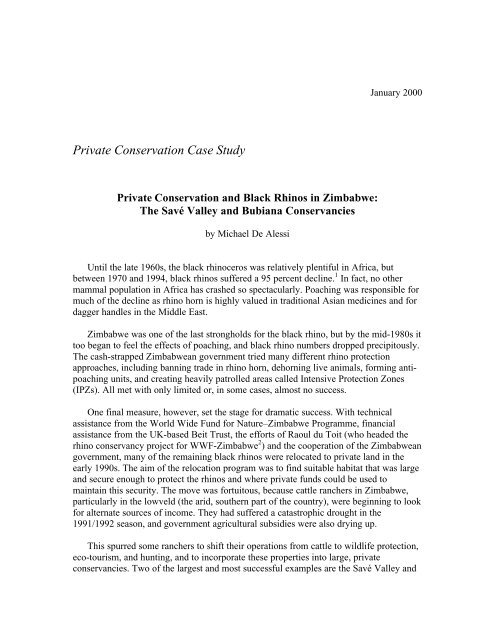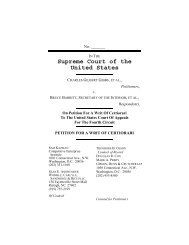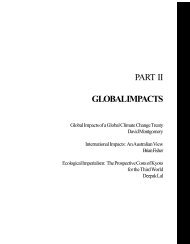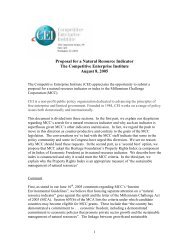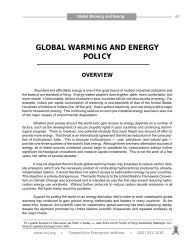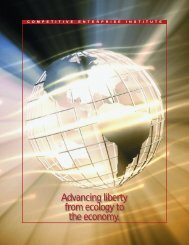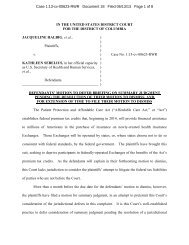Private Conservation and Black Rhinos in Zimbabwe
Private Conservation and Black Rhinos in Zimbabwe
Private Conservation and Black Rhinos in Zimbabwe
You also want an ePaper? Increase the reach of your titles
YUMPU automatically turns print PDFs into web optimized ePapers that Google loves.
<strong>Private</strong> <strong>Conservation</strong> Case Study<br />
<strong>Private</strong> <strong>Conservation</strong> <strong>and</strong> <strong>Black</strong> <strong>Rh<strong>in</strong>os</strong> <strong>in</strong> <strong>Zimbabwe</strong>:<br />
The Savé Valley <strong>and</strong> Bubiana Conservancies<br />
by Michael De Alessi<br />
January 2000<br />
Until the late 1960s, the black rh<strong>in</strong>oceros was relatively plentiful <strong>in</strong> Africa, but<br />
between 1970 <strong>and</strong> 1994, black rh<strong>in</strong>os suffered a 95 percent decl<strong>in</strong>e. 1 In fact, no other<br />
mammal population <strong>in</strong> Africa has crashed so spectacularly. Poach<strong>in</strong>g was responsible for<br />
much of the decl<strong>in</strong>e as rh<strong>in</strong>o horn is highly valued <strong>in</strong> traditional Asian medic<strong>in</strong>es <strong>and</strong> for<br />
dagger h<strong>and</strong>les <strong>in</strong> the Middle East.<br />
<strong>Zimbabwe</strong> was one of the last strongholds for the black rh<strong>in</strong>o, but by the mid-1980s it<br />
too began to feel the effects of poach<strong>in</strong>g, <strong>and</strong> black rh<strong>in</strong>o numbers dropped precipitously.<br />
The cash-strapped <strong>Zimbabwe</strong>an government tried many different rh<strong>in</strong>o protection<br />
approaches, <strong>in</strong>clud<strong>in</strong>g bann<strong>in</strong>g trade <strong>in</strong> rh<strong>in</strong>o horn, dehorn<strong>in</strong>g live animals, form<strong>in</strong>g antipoach<strong>in</strong>g<br />
units, <strong>and</strong> creat<strong>in</strong>g heavily patrolled areas called Intensive Protection Zones<br />
(IPZs). All met with only limited or, <strong>in</strong> some cases, almost no success.<br />
One f<strong>in</strong>al measure, however, set the stage for dramatic success. With technical<br />
assistance from the World Wide Fund for Nature–<strong>Zimbabwe</strong> Programme, f<strong>in</strong>ancial<br />
assistance from the UK-based Beit Trust, the efforts of Raoul du Toit (who headed the<br />
rh<strong>in</strong>o conservancy project for WWF-<strong>Zimbabwe</strong> 2 ) <strong>and</strong> the cooperation of the <strong>Zimbabwe</strong>an<br />
government, many of the rema<strong>in</strong><strong>in</strong>g black rh<strong>in</strong>os were relocated to private l<strong>and</strong> <strong>in</strong> the<br />
early 1990s. The aim of the relocation program was to f<strong>in</strong>d suitable habitat that was large<br />
<strong>and</strong> secure enough to protect the rh<strong>in</strong>os <strong>and</strong> where private funds could be used to<br />
ma<strong>in</strong>ta<strong>in</strong> this security. The move was fortuitous, because cattle ranchers <strong>in</strong> <strong>Zimbabwe</strong>,<br />
particularly <strong>in</strong> the lowveld (the arid, southern part of the country), were beg<strong>in</strong>n<strong>in</strong>g to look<br />
for alternate sources of <strong>in</strong>come. They had suffered a catastrophic drought <strong>in</strong> the<br />
1991/1992 season, <strong>and</strong> government agricultural subsidies were also dry<strong>in</strong>g up.<br />
This spurred some ranchers to shift their operations from cattle to wildlife protection,<br />
eco-tourism, <strong>and</strong> hunt<strong>in</strong>g, <strong>and</strong> to <strong>in</strong>corporate these properties <strong>in</strong>to large, private<br />
conservancies. Two of the largest <strong>and</strong> most successful examples are the Savé Valley <strong>and</strong>
<strong>Private</strong> Conservancies <strong>in</strong> <strong>Zimbabwe</strong> Page 2<br />
Bubiana conservancies. 3 S<strong>in</strong>ce their formation over seven years ago, not a s<strong>in</strong>gle rh<strong>in</strong>o<br />
has been poached <strong>and</strong> black rh<strong>in</strong>o numbers are grow<strong>in</strong>g <strong>in</strong> <strong>Zimbabwe</strong> for the first time <strong>in</strong><br />
decades. Today, these conservancies are dramatic testimonials to the power of private<br />
conservation <strong>in</strong> the develop<strong>in</strong>g world. 4<br />
The <strong>Black</strong> Rh<strong>in</strong>oceros<br />
The black rh<strong>in</strong>oceros (Diceros bicornis) is a savannah species, preferr<strong>in</strong>g thickets <strong>and</strong><br />
savannas to high-canopy forests. It is a browser, feed<strong>in</strong>g primarily on young twigs,<br />
leaves, <strong>and</strong> shoots. Despite its herbivorous diet, the World Wildlife Fund describes the<br />
black rh<strong>in</strong>o as “hostile when disturbed,” 5 to which anyone who has had the pleasure of<br />
track<strong>in</strong>g one on foot can attest as they constantly plot which tree to jump beh<strong>in</strong>d <strong>in</strong> case<br />
1,400 kilos of rh<strong>in</strong>o suddenly charges out of the bush. 6<br />
The black rh<strong>in</strong>o most probably gets its name to dist<strong>in</strong>guish it from the white rh<strong>in</strong>o<br />
(Ceratotherium simum), which has a wider lip than the black rh<strong>in</strong>o. The Afrikaans word<br />
for wide sounds very similar to white, hence the name white rh<strong>in</strong>o. <strong>Black</strong> rh<strong>in</strong>os are not<br />
really black, they are grey, although <strong>in</strong> some cases they may be quite dark.<br />
The black rh<strong>in</strong>o is essentially solitary. Breed<strong>in</strong>g occurs throughout the year, although<br />
<strong>in</strong> certa<strong>in</strong> areas it is concentrated at certa<strong>in</strong> times. Females gestate for over a year, <strong>and</strong> the<br />
time between calves is generally 2½ to 3½ years. If the conditions are optimal, an black<br />
rh<strong>in</strong>o population can exp<strong>and</strong> at just over ten percent per annum.<br />
Both black <strong>and</strong> white rh<strong>in</strong>os are <strong>in</strong>digenous to <strong>Zimbabwe</strong>, but white rh<strong>in</strong>os were<br />
locally extirpated early <strong>in</strong> the century. The white rh<strong>in</strong>o population across the border <strong>in</strong><br />
South Africa was also nearly extirpated, but due to effective conservation efforts, today<br />
they are plentiful, <strong>and</strong> so the species is not considered endangered. The black rh<strong>in</strong>oceros,<br />
however, is listed as endangered on the the World <strong>Conservation</strong> Union (IUCN) red list.<br />
The reason for this status stems primarily from poach<strong>in</strong>g <strong>and</strong> the dem<strong>and</strong> for rh<strong>in</strong>o<br />
horn. 7 Accord<strong>in</strong>g to TRAFFIC, which monitors <strong>in</strong>ternational trade <strong>in</strong> endangered species<br />
<strong>and</strong> animal parts, a s<strong>in</strong>gle rh<strong>in</strong>o horn can sell for as much as $30,000, or for $1,000 a kilo<br />
<strong>in</strong> powdered form. 8 (Of course price figures vary widely, <strong>and</strong> poachers are paid far less<br />
than retail prices). Interest<strong>in</strong>gly, the rh<strong>in</strong>o horn is not actually a bone but a tightly wound<br />
mass of kerat<strong>in</strong> fibers–the same prote<strong>in</strong> that forms the basis of human hair, human<br />
f<strong>in</strong>gernails, <strong>and</strong> horse hooves–which regrows when cut. Rh<strong>in</strong>o horn is a popular<br />
<strong>in</strong>gredient <strong>in</strong> traditional Far Eastern remedies for such ailments as the flu, <strong>and</strong> is also used<br />
to make dagger h<strong>and</strong>les around the Arabian pen<strong>in</strong>sula, particularly <strong>in</strong> Yemen. It is often<br />
reported that rh<strong>in</strong>o horn is valued as an aphrodisiac, but this is not true. Traditional<br />
medic<strong>in</strong>e only values it as a flu remedy. As the author Douglas Adams put it, “There is a<br />
widespread myth about what people want rh<strong>in</strong>o horns for–<strong>in</strong> fact two myths. The first<br />
myth is that ground rh<strong>in</strong>o horn is an aphrodisiac.…The second myth is that anyone<br />
actually believes the first.” 9
<strong>Private</strong> Conservancies <strong>in</strong> <strong>Zimbabwe</strong> Page 3<br />
<strong>Black</strong> Rh<strong>in</strong>o Decl<strong>in</strong>es <strong>and</strong> the Response <strong>in</strong> <strong>Zimbabwe</strong><br />
In 1970, the population of <strong>Black</strong> <strong>Rh<strong>in</strong>os</strong> <strong>in</strong> Africa was estimated at 65,000. 10 By<br />
1995, by some accounts that number was down to as low as 2,400. 11 Strongholds of the<br />
population rema<strong>in</strong>ed primarily <strong>in</strong> South Africa, Namibia, Kenya, <strong>and</strong> <strong>Zimbabwe</strong>.<br />
<strong>Zimbabwe</strong> was difficult to reach for poachers, <strong>and</strong> was one of the last countries to<br />
experience a decl<strong>in</strong>e. In the mid-1980s, accord<strong>in</strong>g to optimistic government estimates,<br />
there were about 3,000 black rh<strong>in</strong>os <strong>in</strong> <strong>Zimbabwe</strong>, the world’s largest population at the<br />
time. By 1989, however, that number was down to 1,750, <strong>and</strong> by 1994, barely 300 were<br />
left <strong>in</strong> the country. 12 Raoul du Toit (now with WWF-<strong>Zimbabwe</strong>), however, has suggested<br />
that the decl<strong>in</strong>e was more gradual than that–that the orig<strong>in</strong>al figure should have been<br />
closer to 2,000 <strong>and</strong> that the poach<strong>in</strong>g pressures started earlier than were officially<br />
recognized. 13 Either way, the black rh<strong>in</strong>o was <strong>in</strong> dire straits by 1994.<br />
Efforts both <strong>in</strong>ternationally <strong>and</strong> with<strong>in</strong> <strong>Zimbabwe</strong> concentrated on try<strong>in</strong>g to make<br />
trade <strong>in</strong> rh<strong>in</strong>o horn difficult, thereby lower<strong>in</strong>g its attractiveness to poachers. International<br />
efforts focused on the Convention on International Trade <strong>in</strong> Endangered Species<br />
(CITES), which enacted an <strong>in</strong>ternational ban on the trade of white rh<strong>in</strong>o parts at its first<br />
conference of the parties <strong>in</strong> 1975. The next meet<strong>in</strong>g, <strong>in</strong> 1977, added the black rh<strong>in</strong>o to the<br />
ban (i.e. added the species to CITES Appendix 1). Nearly 20 years later, however, <strong>in</strong><br />
1994, the black rh<strong>in</strong>o was closer to ext<strong>in</strong>ction than ever before. Accord<strong>in</strong>g to South<br />
African economist Michael ‘t Sas Rolfes, the CITES trade ban “has not had a discernible<br />
effect on rh<strong>in</strong>o numbers <strong>and</strong> does not seem to have stopped the trade <strong>in</strong> rh<strong>in</strong>o horn. If<br />
anyth<strong>in</strong>g, the Appendix I list<strong>in</strong>gs led to a sharp <strong>in</strong>crease <strong>in</strong> the black market price of rh<strong>in</strong>o<br />
horn, which simply fueled further poach<strong>in</strong>g <strong>and</strong> encouraged speculative stockpil<strong>in</strong>g of<br />
horn.” 14<br />
Dur<strong>in</strong>g this time there were also tremendous efforts to protect the black rh<strong>in</strong>o with<strong>in</strong><br />
<strong>Zimbabwe</strong>, also to little or no avail. In 1992, <strong>Zimbabwe</strong> committed itself to a full-scale<br />
dehorn<strong>in</strong>g operation for all of its rh<strong>in</strong>os. Many rh<strong>in</strong>os were dehorned, yet a little more<br />
than one year later, the black rh<strong>in</strong>o population had dropped to under 300 (dehorn<strong>in</strong>g<br />
efforts vastly improved the accuracy of this population estimate). The dehorn<strong>in</strong>g program<br />
may very well have deterred poach<strong>in</strong>g on state l<strong>and</strong>s <strong>and</strong> on private l<strong>and</strong> that could not be<br />
well-protected. Nevertheless, as late as 1994, poachers cont<strong>in</strong>ued to kill rh<strong>in</strong>os “despite<br />
radio collars, dehorn<strong>in</strong>g of hundreds of rh<strong>in</strong>os, use of heavily protected animal<br />
sanctuaries, <strong>and</strong> a shoot-to-kill policy that has left 178 suspected poachers <strong>and</strong> four game<br />
wardens dead.” 15<br />
Dehorn<strong>in</strong>g met with only limited success for a number of reasons, <strong>in</strong>clud<strong>in</strong>g its cost<br />
(up to $1,000 per animal), the rapid regrowth of the horns (dehorn<strong>in</strong>g must be done at<br />
least every other year to be effective), <strong>and</strong> the danger to the rh<strong>in</strong>os when they were<br />
sedated (animals may be overdosed <strong>and</strong> killed). 16 And even recently dehorned animals<br />
have been killed by poachers, perhaps simply to avoid hav<strong>in</strong>g to track the same animal<br />
aga<strong>in</strong>, to <strong>in</strong>crease the price of stockpiled horn, or to obta<strong>in</strong> even what little horn was left.
<strong>Private</strong> Conservancies <strong>in</strong> <strong>Zimbabwe</strong> Page 4<br />
F<strong>in</strong>ally, corruption h<strong>in</strong>dered protection efforts–police, game wardens, <strong>and</strong> even a member<br />
of Parliament have been convicted of either kill<strong>in</strong>g rh<strong>in</strong>os or trad<strong>in</strong>g <strong>in</strong> rh<strong>in</strong>o horn. 17<br />
In the latter part of 1993, <strong>Zimbabwe</strong>’s then-m<strong>in</strong>ister of environment, Herbert<br />
Murerwa, admitted the government’s dehorn<strong>in</strong>g operation had failed to stop the<br />
poach<strong>in</strong>g, <strong>and</strong> the rema<strong>in</strong><strong>in</strong>g rh<strong>in</strong>os were moved <strong>in</strong>to smaller areas known as Intensive<br />
Protection Zones (IPZs). 18 The IPZs were an improvement, but failed to address the<br />
corruption issue or to adequately protect the rema<strong>in</strong><strong>in</strong>g rh<strong>in</strong>os.<br />
Not surpris<strong>in</strong>gly, many pundits predicted the demise of the black rh<strong>in</strong>o. A front page<br />
story <strong>in</strong> the Los Angeles Times <strong>in</strong> 1994 called efforts to save the black rh<strong>in</strong>oceros a<br />
“los<strong>in</strong>g battle” <strong>and</strong> claimed that “by all accounts, [the black rh<strong>in</strong>oceros] may be<br />
doomed.” 19 The magaz<strong>in</strong>e Buzzworm carried an even more apocalyptic article the same<br />
year, simply headl<strong>in</strong>ed “The Rh<strong>in</strong>o Cha<strong>in</strong>saw Massacre: Why <strong>Rh<strong>in</strong>os</strong> Will Not Survive<br />
the Century.” 20<br />
In the early 1900s, the same had been said of the southern white rh<strong>in</strong>oceros <strong>in</strong> South<br />
Africa. In fact, the white rh<strong>in</strong>o was believed to have been extirpated from South Africa at<br />
the end of the last century before a lone population of less than 100 animals was<br />
discovered <strong>in</strong> Natal, South Africa. In the ensu<strong>in</strong>g decades, however, the Natal Parks<br />
Board took a radically different approach to rh<strong>in</strong>o conservation from the rest of the<br />
cont<strong>in</strong>ent. Instead of try<strong>in</strong>g to devalue the rh<strong>in</strong>os, it strove to bolster their populations<br />
through a program of commercial use <strong>and</strong> management, which <strong>in</strong>cluded reestablish<strong>in</strong>g<br />
the rh<strong>in</strong>os on private l<strong>and</strong>s <strong>and</strong>, s<strong>in</strong>ce 1986, auction<strong>in</strong>g them to the private sector for both<br />
trophy hunt<strong>in</strong>g <strong>and</strong> non-consumptive tourism.<br />
The results have been spectacular. At the turn of the century the southern white rh<strong>in</strong>o<br />
was the most endangered of all the rh<strong>in</strong>o species. Today it is more numerous than all the<br />
other rh<strong>in</strong>o species put together. 21 And it is still grow<strong>in</strong>g fast–the number of white rh<strong>in</strong>os<br />
was estimated to be about 7,500 <strong>in</strong> 1995 <strong>and</strong> 8,500 <strong>in</strong> 1997. 22 In 1997, 20 percent of the<br />
white rh<strong>in</strong>os <strong>in</strong> South Africa were <strong>in</strong> private h<strong>and</strong>s. 23 It was this conservation success on<br />
private l<strong>and</strong> that encouraged the creation of private conservancies <strong>in</strong> <strong>Zimbabwe</strong>.<br />
There is no legal def<strong>in</strong>ition of a conservancy <strong>in</strong> <strong>Zimbabwe</strong>, but accord<strong>in</strong>g to Raoul du<br />
Toit, <strong>in</strong> <strong>Zimbabwe</strong>, South Africa, <strong>and</strong> Namibia the generally accepted notion of a<br />
conservancy is that it is made up of two or more l<strong>and</strong>holders (not necessarily all private)<br />
bound together by an agreement on jo<strong>in</strong>t management of some or all of their wildlife<br />
resources. 24 Mr. du Toit notes that the IUCN African Rh<strong>in</strong>o Specialist Group has def<strong>in</strong>ed<br />
a rh<strong>in</strong>o conservancy as “a relatively large fenced area of primarily or entirely private l<strong>and</strong><br />
under the control of two or more l<strong>and</strong>holders, where staff are deployed at moderate to<br />
high density to protect the rh<strong>in</strong>o population, <strong>and</strong> where the need for biological<br />
management is reduced.” Accord<strong>in</strong>g to this def<strong>in</strong>ition, the only <strong>Zimbabwe</strong>an rh<strong>in</strong>o<br />
conservancies other than Savé Valley <strong>and</strong> Bubiana are the Chiredzi River Conservancy<br />
(with 18 black rh<strong>in</strong>os), also <strong>in</strong> the lowveld, <strong>and</strong> the Midl<strong>and</strong>s Conservancy (with about 40<br />
black rh<strong>in</strong>os) <strong>in</strong> the central part of the country.
<strong>Private</strong> Conservancies <strong>in</strong> <strong>Zimbabwe</strong> Page 5<br />
The Formation of the Lowveld Conservancies<br />
While headl<strong>in</strong>es <strong>in</strong> 1994 still claimed that “<strong>Zimbabwe</strong> is los<strong>in</strong>g the rh<strong>in</strong>o war,” 25 only<br />
a year later a radically different story began to appear. Headl<strong>in</strong>es began to read, “Big-<br />
Game Hunters Pay to Conserve Wildlife,” <strong>and</strong>, “<strong>Zimbabwe</strong>’s <strong>Rh<strong>in</strong>os</strong> Make a Come<br />
back.” 26 The private conservancies were the difference. As the majority of black rh<strong>in</strong>os<br />
were moved to the conservancies, their population <strong>in</strong> <strong>Zimbabwe</strong> went from 300 <strong>in</strong> 1994,<br />
to 339 <strong>in</strong> 1997, to nearly 400 <strong>in</strong> 1998. 27 For the first time <strong>in</strong> decades the population was<br />
<strong>in</strong>creas<strong>in</strong>g.<br />
Back <strong>in</strong> 1986, <strong>in</strong> response to the worsen<strong>in</strong>g black rh<strong>in</strong>o situation, the <strong>Zimbabwe</strong><br />
Department of National Parks <strong>and</strong> Wildlife Management (DNPWLM) began mov<strong>in</strong>g<br />
rh<strong>in</strong>os out of the Zambezi Valley to areas of private l<strong>and</strong> <strong>in</strong> <strong>Zimbabwe</strong> (the Zambezi<br />
valley is close to Zambia, where it was alleged that most of the poachers came from).<br />
Most of those moved were placed on ranches <strong>in</strong> the Midl<strong>and</strong>s, a central portion of the<br />
country which was not ideally suited to the rh<strong>in</strong>os, <strong>and</strong> the program met with only<br />
moderate success, although the situation has improved s<strong>in</strong>ce then <strong>in</strong> the Midl<strong>and</strong>s. 28<br />
Another start<strong>in</strong>g po<strong>in</strong>t for the conservancies came <strong>in</strong> 1989, when a British-based<br />
organization that had supported projects <strong>in</strong> <strong>Zimbabwe</strong> for decades, the Beit Trust, 29<br />
announced an <strong>in</strong>terest <strong>in</strong> provid<strong>in</strong>g grant money for rh<strong>in</strong>o conservation through the<br />
<strong>Zimbabwe</strong> program office of the World Wide Fund for Nature. Based at least partially on<br />
the success of the white rh<strong>in</strong>o recovery <strong>in</strong> South Africa, WWF-<strong>Zimbabwe</strong>, <strong>and</strong> Raoul du<br />
Toit <strong>in</strong> particular, proposed us<strong>in</strong>g the Beit Trust money to help establish viable breed<strong>in</strong>g<br />
groups of rh<strong>in</strong>os <strong>in</strong> free-rang<strong>in</strong>g situations on large areas of private l<strong>and</strong>. 30 Once the<br />
program was <strong>in</strong>itiated, these private l<strong>and</strong>s would then have to be self-sufficient.<br />
Before it could move forward, the conservancy project had to be approved by<br />
DNPWLM. It has been estimated that <strong>in</strong> order to be effective, an anti-poach<strong>in</strong>g program<br />
requires US$400-1,000 annually per square kilometer of rh<strong>in</strong>oceros habitat, <strong>and</strong> a staff<br />
complement of one person for every 20 kilometers. 31 This was money that DNPWLM<br />
simply did not have, <strong>and</strong> it helped conv<strong>in</strong>ce them to approve the proposal <strong>in</strong> 1990.<br />
The Rh<strong>in</strong>o Conservancy Project (RCP) officially began <strong>in</strong> 1991 with the one-time<br />
grant of one million British pounds from the Beit Trust. Both WWF-<strong>Zimbabwe</strong> <strong>and</strong> the<br />
DNPWLM agreed that private ranchers were <strong>in</strong> a better position to protect the rh<strong>in</strong>os than<br />
anyone else <strong>in</strong> <strong>Zimbabwe</strong>. They also understood that the rh<strong>in</strong>os had to be an asset for<br />
those ranchers to protect them. The program got off to a slow start because of the rapidlyworsen<strong>in</strong>g<br />
plight of the black rh<strong>in</strong>o, which took DNPWLM staff time away for dehorn<strong>in</strong>g<br />
operations <strong>and</strong> resulted <strong>in</strong> fewer rh<strong>in</strong>os available for transplant<strong>in</strong>g. 32 Dur<strong>in</strong>g 1992, several<br />
lone survivors were captured <strong>in</strong> the Zambezi Valley, <strong>and</strong> between May <strong>and</strong> June of 1993,<br />
a larger number of black rh<strong>in</strong>os were transported from the Midl<strong>and</strong>s to the lowveld<br />
conservancies. 33
<strong>Private</strong> Conservancies <strong>in</strong> <strong>Zimbabwe</strong> Page 6<br />
Conv<strong>in</strong>c<strong>in</strong>g a large group of ranchers to convert their operations from cattle to<br />
wildlife was also a difficult proposition, but much less so after the severe drought of<br />
1991/92. The lowveld of <strong>Zimbabwe</strong> was already a somewhat marg<strong>in</strong>al area for cattle, <strong>and</strong><br />
much of the l<strong>and</strong> was denuded by the late 1980s. Wildlife certa<strong>in</strong>ly suffered, but cattle<br />
were devastated. The drought highlighted the resiliency of the plants <strong>and</strong> animals that had<br />
evolved to survive <strong>in</strong> the lowveld. “When the drought ended, we decided never to return<br />
to beef, which had been runn<strong>in</strong>g at a loss for years,” Derek Henn<strong>in</strong>g, a Savé member,<br />
said. 34<br />
Another impetus for the conservancy project was a 1994 Price Waterhouse<br />
consultancy report (commissioned by the conservancies <strong>and</strong> WWF-<strong>Zimbabwe</strong>/Beit Trust<br />
to explore the l<strong>and</strong>-use options available to the conservancies) which concluded that,<br />
“from a f<strong>in</strong>ancial perspective, wildlife is a more desirable l<strong>and</strong>-use than cattle <strong>in</strong> these<br />
Conservancies.” 35 For example, on the Senuko property <strong>in</strong> the Savé Conservancy, it was<br />
estimated that the return on capital from cattle would range from 1-3 percent, whereas<br />
wildlife could return 11 percent. Thus, f<strong>in</strong>ancial consideration was the prime motivation<br />
for the formation of the lowveld conservancies.<br />
Revenues from the conservancies come from both consumptive <strong>and</strong> non-consumptive<br />
uses of wildlife. The most popular non-consumptive activities are photo-safaris <strong>and</strong><br />
birdwatch<strong>in</strong>g. A major attraction of the conservancies is the chance to see the “big five”–<br />
rh<strong>in</strong>oceros, elephant, lion, leopard, <strong>and</strong> buffalo. All may be found, <strong>and</strong> although lions are<br />
sparse, there are plans to restock them <strong>in</strong> the near future. There is also some meat<br />
production, but the primary consumptive revenue comes from hunt<strong>in</strong>g, mostly of various<br />
antelope species.<br />
As for the rh<strong>in</strong>o, there is no doubt it has been well-protected by the lowveld<br />
conservancies. For every rh<strong>in</strong>o there is also at least one armed guard track<strong>in</strong>g it all day<br />
(they are effectively impossible to follow at night), <strong>and</strong> not a s<strong>in</strong>gle one has been<br />
poached. 36 Additionally, their numbers are <strong>in</strong>creas<strong>in</strong>g at near their biological maximum.<br />
The Savé Valley Conservancy<br />
The Savé Valley Conservancy is a truly remarkable place. Located <strong>in</strong> the southeastern<br />
part of the country, about 70 km northeast of the town of Chiredzi <strong>and</strong> bounded<br />
by Savé River to the east, it occupies over 850,000 acres, mak<strong>in</strong>g it Africa’s largest<br />
private wildlife reserve. Even more remarkable than its shear size is the complete<br />
transformation it has undergone s<strong>in</strong>ce the late 1980s, when it was pa<strong>in</strong>fully clear that the<br />
region was suffer<strong>in</strong>g serious environmental degradation from overgraz<strong>in</strong>g <strong>and</strong> a series of<br />
droughts.<br />
Wildlife was also severely depleted, both by the drought <strong>and</strong> by the impact of cattle<br />
ranch<strong>in</strong>g. In the early 1970s, to prevent the spread of hoof <strong>and</strong> mouth disease, the<br />
Department of Veter<strong>in</strong>ary Services systematically eradicated the buffalo <strong>and</strong> all but five<br />
elephants throughout the present Conservancy. Predators such as lions, cheetahs, wild
<strong>Private</strong> Conservancies <strong>in</strong> <strong>Zimbabwe</strong> Page 7<br />
dogs, <strong>and</strong> hyenas were also removed to reduce stock losses, but a healthy leopard<br />
population did manage to survive. 37 Still, there was quite a bit of wildlife <strong>in</strong> the area<br />
because, accord<strong>in</strong>g to Clive Stockil, one of the ranch owners <strong>and</strong> catalysts for the<br />
formation of the conservancy, “Prior to the <strong>in</strong>troduction of cattle <strong>in</strong> the 1950s <strong>and</strong> 1960s,<br />
no national park <strong>in</strong> <strong>Zimbabwe</strong> supported as diverse a wildlife population as this area.” 38<br />
When, out of desperation, the DNPWLM relocated a number of black rh<strong>in</strong>os to<br />
private l<strong>and</strong>s <strong>in</strong> 1987, some of them wound up on one of the Savé ranches. Humani<br />
Ranch was owned by Roger Whittall, a well-known conservationist <strong>and</strong> safari operator<br />
who was already switch<strong>in</strong>g his l<strong>and</strong> from cattle to wildlife. Dur<strong>in</strong>g this <strong>in</strong>itial phase of<br />
limited, experimental translocations (which preceded the Rh<strong>in</strong>o Conservancy Project), 20<br />
black rh<strong>in</strong>os were brought to the Humani Ranch.<br />
When the rh<strong>in</strong>os first arrived, there was no concrete plan to form a conservancy, but it<br />
soon became clear that a s<strong>in</strong>gle ranch could not adequately protect the rh<strong>in</strong>os, who<br />
frequently strayed from the property. By 1990, four had been killed by poachers. 39 It was<br />
also determ<strong>in</strong>ed that the m<strong>in</strong>imum breed<strong>in</strong>g group should be 30-40 animals, <strong>and</strong> that the<br />
ideal stock<strong>in</strong>g rate was one per ten square kilometers.<br />
It was at about this time that the Rh<strong>in</strong>o Conservancy Project got under way, <strong>and</strong><br />
Raoul du Toit, the project manager, became another catalyst <strong>in</strong> the formation of the<br />
conservancy. In August 1990, ranchers <strong>in</strong> the Savé Valley voted to form the<br />
Conservancy, which at the time consisted of 18 members <strong>and</strong> 23 properties. That number<br />
has s<strong>in</strong>ce risen to 21 members <strong>and</strong> 25 properties. In 1991, the members agreed on the<br />
<strong>in</strong>itial aim of provid<strong>in</strong>g a sanctuary for the seriously threatened black rh<strong>in</strong>oceros. After<br />
the 1991/1992 drought, <strong>in</strong> November 1992, the members held a meet<strong>in</strong>g to evaluate their<br />
l<strong>and</strong>-use options, <strong>and</strong> resolved to pursue the wildlife option.<br />
They also decided that they had to go for the “big five,” which meant re<strong>in</strong>troduc<strong>in</strong>g<br />
buffalo. Buffalo are crucial for photo safaris, <strong>and</strong> it was also estimated that buffalo would<br />
more than double the f<strong>in</strong>ancial returns to hunt<strong>in</strong>g. 40 Buffalo carry hoof <strong>and</strong> mouth<br />
disease, <strong>and</strong> the Department of Veter<strong>in</strong>ary Services would not allow them to be<br />
re<strong>in</strong>troduced as long as any cattle rema<strong>in</strong>ed. Thus, a commitment to buffalo also meant a<br />
commitment to completely remove all cattle from the Conservancy. To allay the fears of<br />
their neighbors <strong>and</strong> to placate Veter<strong>in</strong>ary Services, as the conservancy was tear<strong>in</strong>g down<br />
all of its <strong>in</strong>ternal fenc<strong>in</strong>g, it also set up a double electric fence around the entire property,<br />
as much to keep the buffalo <strong>in</strong> as anyth<strong>in</strong>g else.<br />
On a recent visit to the conservancy, it was obvious that the l<strong>and</strong> was still not<br />
completely rehabilitated, but the transformation <strong>and</strong> the progress to date were stunn<strong>in</strong>g.<br />
Native grasses <strong>and</strong> shrubs were com<strong>in</strong>g back <strong>in</strong> strength, <strong>and</strong> so was the wildlife. Today,<br />
the Savé boasts large numbers of species such as buffalo, zebra, giraffe, warthog,<br />
wildebeest, hippo, leopard, cheetah, <strong>and</strong> elephant. Dur<strong>in</strong>g the 1991/1992 drought, the<br />
elephant population <strong>in</strong> nearby Gonarezhou National Park suffered tremendously. A<br />
number of these animals were later relocated to the Savé, the first time a relocation effort
<strong>Private</strong> Conservancies <strong>in</strong> <strong>Zimbabwe</strong> Page 8<br />
moved whole family units. From that orig<strong>in</strong>al number of 600 elephants, there are now<br />
well over 1,000. There are also grow<strong>in</strong>g populations of impala, kudu, el<strong>and</strong>, bushbuck,<br />
bushpig, sable, <strong>and</strong> waterbuck. Many of these species have been re<strong>in</strong>troduced on the<br />
property, <strong>and</strong> the resident predators–leopard, cheetah, <strong>and</strong> the endangered wild dog–are<br />
grow<strong>in</strong>g with them. Species still slated to be supplemented or re<strong>in</strong>troduced <strong>in</strong>clude<br />
buffalo, el<strong>and</strong>, elephant, giraffe, hartebeest, nyala, ostrich, roan, sable, tsessebe,<br />
wildebeest, hyena, lion, <strong>and</strong> white rh<strong>in</strong>o.<br />
Of all the species on the conservancy, however, the black rh<strong>in</strong>os garner the most<br />
attention. The Savé has one of the largest black rh<strong>in</strong>o populations <strong>in</strong> <strong>Zimbabwe</strong>, <strong>and</strong> their<br />
numbers are grow<strong>in</strong>g rapidly. By 1993, 35 rh<strong>in</strong>o had been relocated to the conservancy.<br />
By June 1997 that number had grown, through natural recruitment, to 57. 41 This near 12<br />
percent per annum <strong>in</strong>crease <strong>in</strong> the black rh<strong>in</strong>o population is the highest ever recorded, <strong>and</strong><br />
exceeds the predicted <strong>in</strong>crease under optimal conditions. 42<br />
The first property to open for non-consumptive tourism was Senuko, owned by Clive<br />
Stockil. Clive has had a long <strong>and</strong> varied career <strong>in</strong> wildlife management <strong>and</strong> was crucial to<br />
the formation of the conservancy. He is now the chairman of the Savé Valley<br />
Conservancy. He is also a member of the IUCN Southern Africa Rh<strong>in</strong>o Specialist Group<br />
<strong>and</strong> the IUCN Southern Africa Susta<strong>in</strong>able Use Group. In 1997 he won the third annual<br />
Traveler Ecotourism award for his work with the nearby Shangaan tribespeople to<br />
develop a luxury safari lodge known as Mahenye. 43 Clive was quoted <strong>in</strong> the Condé Nast<br />
article say<strong>in</strong>g that the solution to the strife between the Shangaans <strong>and</strong> National Parks<br />
“lay <strong>in</strong> grant<strong>in</strong>g the Shangaans ownership <strong>and</strong> management of the wildlife on their<br />
l<strong>and</strong>.” 44<br />
The Senuko lodge provides another example of a peaceful resolution to a serious<br />
problem. Many of the game drives <strong>and</strong> track<strong>in</strong>gs there are led by Kenneth Manyangadze,<br />
who is the head guide at Senuko. Kenneth was formerly a sergeant of Operation<br />
Stronghold–the National Parks effort to protect the rh<strong>in</strong>o on the ground that witnessed the<br />
decl<strong>in</strong>e of the rh<strong>in</strong>o <strong>in</strong> spite of the often violent <strong>and</strong> mortal confrontations with poachers.<br />
Stay<strong>in</strong>g at the Senuko Safari Lodge is a magical experience. Luxurious bungalows are<br />
clustered on a kopje (granite hill), creat<strong>in</strong>g a feel<strong>in</strong>g of nest<strong>in</strong>g on the rocks. Days are<br />
spent on game drives, track<strong>in</strong>g rh<strong>in</strong>os or elephants, birdwatch<strong>in</strong>g, or simply tak<strong>in</strong>g <strong>in</strong> the<br />
view. A highlight of a visit <strong>in</strong> 1997 <strong>in</strong>cluded wait<strong>in</strong>g patiently for a pack of wild dogs to<br />
return to their den, which was full of pups. Another afternoon was spent track<strong>in</strong>g a rh<strong>in</strong>o,<br />
which was unsuccessful but did provide the distraction of nearly stumbl<strong>in</strong>g on top of a<br />
ten-foot-long python.<br />
The Bubiana Conservancy<br />
The Bubiana Conservancy is another remarkable effort, ly<strong>in</strong>g <strong>in</strong> the southwestern<br />
lowveld below Bulawayo, not far from the town of West Nicholson. Bubiana was formed<br />
<strong>in</strong> June 1991 by seven ranchers whose 10 properties make up the conservancy’s nearly
<strong>Private</strong> Conservancies <strong>in</strong> <strong>Zimbabwe</strong> Page 9<br />
400,000 acres. Bubiana’s success has been similar to the Savé. The conservancy started<br />
with 38 <strong>in</strong>troduced rh<strong>in</strong>os, <strong>and</strong> by 1998 that number had grown to 69. 45 Bubiana also<br />
assigns guards to track each rh<strong>in</strong>o every day, <strong>and</strong> they are breed<strong>in</strong>g up quickly, at about<br />
ten percent per annum.<br />
Bubiana was also jump-started by f<strong>in</strong>ancial assistance from the Beit Trust, which<br />
helped to build the 216 km fence around the perimeter. A condition of this “loan” was<br />
that the conservancy would not have to pay it back as long as it <strong>in</strong>vested at least the same<br />
amount to purchase game animals to boost wildlife populations with<strong>in</strong> the conservancy<br />
(the same policy applied to the Savé as well). 46<br />
Apart from the black rh<strong>in</strong>os, Bubiana is especially well-known for its population of<br />
leopards, as evidenced by the snarl<strong>in</strong>g caricature that greets visitors on the Bubiana road<br />
signs. The variety of wildlife <strong>in</strong> the conservancy is certa<strong>in</strong>ly both impressive <strong>and</strong> rapidly<br />
exp<strong>and</strong><strong>in</strong>g. 390 species of birds have been counted on the property, which <strong>in</strong>cludes a<br />
wide variety of raptors such as the black eagle <strong>and</strong> the fish eagle.<br />
There is one important difference between the two conservancies, which arises from<br />
the greater viability of cattle ranch<strong>in</strong>g <strong>in</strong> <strong>and</strong> around Bubiana. For this reason, the<br />
conservancy has not totally committed itself to wildlife. It is still considered a “green”<br />
zone by Veter<strong>in</strong>ary Services, mean<strong>in</strong>g that it is still free of hoof <strong>and</strong> mouth disease. Many<br />
properties still run cattle on parts of their l<strong>and</strong>. There are a small number of buffalo <strong>in</strong> the<br />
conservancy, but they all orig<strong>in</strong>ated from disease-free stock. Disease-free buffalo are<br />
much more expensive, <strong>and</strong> so there are only about one hundred <strong>in</strong> the conservancy.<br />
Because Bubiana’s members have different ideas regard<strong>in</strong>g the extent to which<br />
wildlife should replace traditional ranch<strong>in</strong>g <strong>and</strong> agriculture, each property has taken a<br />
slightly different approach to revenue generation, <strong>in</strong>clud<strong>in</strong>g non-consumptive tourism,<br />
trophy hunt<strong>in</strong>g, a large cattle operation, irrigated agriculture, commercial fish<strong>in</strong>g, <strong>and</strong><br />
ostrich <strong>and</strong> crocodile farm<strong>in</strong>g. 47 Except for the cattle one passes on the drive <strong>in</strong> to<br />
Barberton, however, one would never notice their presence on this vast expanse of l<strong>and</strong>.<br />
The Barberton Lodge is perched atop a kopje, with an absolutely stunn<strong>in</strong>g view of the<br />
countryside. Most amaz<strong>in</strong>g, perhaps, about the view is that all of the African savannah, as<br />
far as the eye can see (which is a long way) is still with<strong>in</strong> the boundaries of the<br />
conservancy. Below the cab<strong>in</strong>s there is also a good view of a water<strong>in</strong>g hole that attracts<br />
all sorts of wildlife, <strong>and</strong> a paddock where some of the buffalo are kept at night.<br />
The activities available to the lodge guests are varied, <strong>and</strong> dur<strong>in</strong>g a 1997 stay<br />
<strong>in</strong>cluded game drives, game rides on horseback, visits to see centuries-old bushmen<br />
pa<strong>in</strong>t<strong>in</strong>gs, <strong>and</strong> a boat ride on a dam filled with crocodiles <strong>and</strong> a fantastic array of bird<br />
species. But of course the highlight was track<strong>in</strong>g <strong>and</strong> glimps<strong>in</strong>g one of the black rh<strong>in</strong>os.<br />
They must be tracked on foot, <strong>and</strong> it is difficult to describe the exhilaration of see<strong>in</strong>g such<br />
a prehistoric-look<strong>in</strong>g behemoth up close.
<strong>Private</strong> Conservancies <strong>in</strong> <strong>Zimbabwe</strong> Page 10<br />
<strong>Conservation</strong> through Commerce <strong>and</strong> the Importance of Hunt<strong>in</strong>g<br />
Creat<strong>in</strong>g the lowveld conservancies was a f<strong>in</strong>ancial decision at heart, <strong>and</strong> after the<br />
seed money from the Beit Trust was used up, wildlife had to start pay<strong>in</strong>g its way. This<br />
meant either consumptive (i.e. hunt<strong>in</strong>g or meat production) or non-consumptive (i.e.<br />
game view<strong>in</strong>g, photography, <strong>and</strong> birdwatch<strong>in</strong>g) use of wildlife.<br />
Photo safaris <strong>and</strong> other non-consumptive activities can be quite lucrative, but take a<br />
great deal of time <strong>and</strong> <strong>in</strong>vestment to set up. Guests expect comfortable accommodations,<br />
quality meals <strong>and</strong> a range of activities. This <strong>in</strong> turn means a fair number of staff. Hunters,<br />
on the other h<strong>and</strong>, are often more happy with Spartan amenities, <strong>and</strong> one or two game<br />
scouts.<br />
While stay<strong>in</strong>g at the Barberton Lodge costs about $160 per night for a photo safari,<br />
other Bubiana properties charge between $500 <strong>and</strong> $1,000 per day for a hunt<strong>in</strong>g safari, on<br />
top of whatever trophy fees are <strong>in</strong>curred. For an animal like a leopard, the trophy fee can<br />
be over $3,000. 48 Because of the low overhead <strong>and</strong> high return, hunt<strong>in</strong>g is, as one<br />
Bubiana partner was quoted as say<strong>in</strong>g, “a low-cost entry option to benefit<strong>in</strong>g from<br />
wildlife.” 49 It is also the reason why all of the Bubiana partners are now turn<strong>in</strong>g a profit<br />
from their wildlife operations.<br />
While it may seem gruesome to some, there is no doubt that trophy hunt<strong>in</strong>g provides<br />
huge <strong>in</strong>centives to protect wildlife throughout Africa. No elephants are hunted <strong>in</strong> the<br />
conservancies, but elsewhere <strong>in</strong> <strong>Zimbabwe</strong>, hunters pay up to $36,000 for a three-week<br />
chance at track<strong>in</strong>g <strong>and</strong> kill<strong>in</strong>g one. 50 And while no black rh<strong>in</strong>o may be hunted anywhere<br />
<strong>in</strong> <strong>Zimbabwe</strong>, it has been estimated that the fee for a permit to hunt one could be as high<br />
as $250,000. 51<br />
Dave Foreman, a founder of EarthFirst! <strong>and</strong> now head of the Wildl<strong>and</strong>s project,<br />
recently visited <strong>Zimbabwe</strong> <strong>and</strong> was exposed to some of the realities of conservation <strong>in</strong><br />
Africa. After his trip he was quoted <strong>in</strong> The Idaho Statesman say<strong>in</strong>g, “I f<strong>in</strong>d shoot<strong>in</strong>g<br />
elephants…repulsive. I’d never do it. But if hunt<strong>in</strong>g will save elephants…then I support<br />
it.” 52<br />
Unfortunately, that sentiment is rare <strong>in</strong> the environmental community, <strong>and</strong> many<br />
groups either oppose any sort of consumptive use for wildlife, or choose to ignore the<br />
successes that it has generated. Even the World Wide Fund for Nature, whose program<br />
office <strong>in</strong> <strong>Zimbabwe</strong> played a major role <strong>in</strong> both the movement of the rh<strong>in</strong>os onto private<br />
l<strong>and</strong>s <strong>and</strong> the creation of the conservancies, hardly acknowledges the success of the<br />
conservancies. WWF International’s website has a page entitled “What WWF is Do<strong>in</strong>g to<br />
Save the Rh<strong>in</strong>o,” which has no mention of any private conservation activities. 53 Another<br />
page, entitled “What Needs to be Done,” highlights the fact that “rh<strong>in</strong>o habitat needs to<br />
be protected from fragmentation <strong>and</strong> degradation so that viable rh<strong>in</strong>o populations can<br />
survive.” 54 That is, of course, exactly what the conservancies have already done, but<br />
WWF fails to mention that <strong>and</strong> only goes on to call for “government management
<strong>Private</strong> Conservancies <strong>in</strong> <strong>Zimbabwe</strong> Page 11<br />
authorities [to] allocate more resources <strong>in</strong>to rh<strong>in</strong>o conservation” <strong>and</strong> for “mak<strong>in</strong>g CITES<br />
work.”<br />
Of course, the CITES ban on trade <strong>in</strong> rh<strong>in</strong>o horn did little to stave off the rapid<br />
decl<strong>in</strong>e of the <strong>Zimbabwe</strong>an rh<strong>in</strong>os, <strong>and</strong> while call<strong>in</strong>g for more government moneys may<br />
sound f<strong>in</strong>e, especially <strong>in</strong> develop<strong>in</strong>g countries, the only way to generate those funds is to<br />
wed conservation <strong>and</strong> commerce. In fact, a major impetus for relocat<strong>in</strong>g the rh<strong>in</strong>os <strong>in</strong><br />
<strong>Zimbabwe</strong> on to private l<strong>and</strong> was that National Parks simply did not have the resources to<br />
monitor <strong>and</strong> protect the rh<strong>in</strong>o. By contrast, the Natal Parks board <strong>in</strong> South Africa<br />
embraced the notion of conservation through commerce long ago, sell<strong>in</strong>g both hunts <strong>and</strong><br />
live animals to support its white rh<strong>in</strong>o conservation activities, <strong>and</strong> br<strong>in</strong>g<strong>in</strong>g that species<br />
back from the br<strong>in</strong>k of ext<strong>in</strong>ction.<br />
There is an even greater urgency to comb<strong>in</strong>e conservation <strong>and</strong> commerce <strong>in</strong><br />
develop<strong>in</strong>g countries like <strong>Zimbabwe</strong>, where poverty is widespread. 55 If wildlife on<br />
communal l<strong>and</strong>s does not pay its way, it may simply be replaced by someth<strong>in</strong>g that does.<br />
This was one impetus beh<strong>in</strong>d the CAMPFIRE program <strong>in</strong> <strong>Zimbabwe</strong>, which gives control<br />
over wildlife to local communities so that they can realize the benefits of allocat<strong>in</strong>g l<strong>and</strong><br />
to wildlife. 56 The program has had its share of difficulties over the years, but has also<br />
shown that when wildlife has value to the people liv<strong>in</strong>g with <strong>and</strong> around it, they will be<br />
more likely to protect <strong>and</strong> provide habitat for wildlife.<br />
Wildlife Law <strong>and</strong> the Conservancy Constitutions<br />
In 1975, there was a crucial change <strong>in</strong> the wildlife law of <strong>Zimbabwe</strong> that set the stage<br />
for the resurgence <strong>in</strong> conservation activities on both private <strong>and</strong> communal l<strong>and</strong>s. The<br />
Parks <strong>and</strong> Wildlife Act of 1975 abolished the conventional, colonial-style state controls<br />
on hunt<strong>in</strong>g seasons, off-take quotas, license fees, etc., <strong>and</strong> <strong>in</strong>stead conferred the right to<br />
manage wildlife to l<strong>and</strong>owners. 57<br />
In a strict legal sense, wildlife <strong>in</strong> <strong>Zimbabwe</strong> was still owned by no one (res nullius),<br />
but because l<strong>and</strong>owners could now utilize <strong>and</strong> control the animals on their l<strong>and</strong>, they<br />
became the de facto owners of the wildlife on their property. The black rh<strong>in</strong>os are the<br />
exception, as the state explicitly reta<strong>in</strong>ed ownership of the relocated rh<strong>in</strong>os <strong>in</strong> the<br />
agreements they signed with the conservancies. Based on the success of the<br />
conservancies, however, there is little chance that they will be relocated aga<strong>in</strong>. Just who<br />
owns the offspr<strong>in</strong>g may one day lead to some controversy, but for now the situation is<br />
very stable.<br />
The right to manage wildlife was readily extended to private contractual<br />
arrangements govern<strong>in</strong>g the mutual use of wildlife by groups of l<strong>and</strong>owners. A variable<br />
<strong>and</strong> unpredictable environment <strong>in</strong> the lowveld made large-scale l<strong>and</strong> management<br />
particularly attractive, <strong>and</strong> so the conservancy members created just those k<strong>in</strong>ds of<br />
contracts. 58
<strong>Private</strong> Conservancies <strong>in</strong> <strong>Zimbabwe</strong> Page 12<br />
The Savé <strong>and</strong> Bubiana constitutions oblige their members to share responsibility for<br />
wildlife re-stock<strong>in</strong>g <strong>and</strong> management, but allow them to reta<strong>in</strong> control over their<br />
properties. Follow<strong>in</strong>g regular wildlife surveys <strong>and</strong> professional ecological advice, each<br />
conservancy member is allocated an annual quota for the consumptive utilization of<br />
different wildlife species on their property. Members then decide how they want to use<br />
this quota (e.g., for safari hunt<strong>in</strong>g, live sales of wildlife, game cropp<strong>in</strong>g, or no harvest<br />
whatsoever). 59<br />
Revenues are not shared between properties, but each member commits to a<br />
m<strong>in</strong>imum level of fund<strong>in</strong>g for restock<strong>in</strong>g <strong>and</strong> wildlife management. To encourage<br />
fund<strong>in</strong>g beyond this m<strong>in</strong>imum, <strong>and</strong> to allow <strong>in</strong>dividuals to benefit from either greater<br />
<strong>in</strong>vestment or non-consumptive use, Savé Valley Wildlife Services, Ltd. (the company<br />
set up by the conservancy) credits members who restock beyond the required m<strong>in</strong>imum<br />
aga<strong>in</strong>st future payments (at the prevail<strong>in</strong>g market price of the animals).<br />
On the other h<strong>and</strong>, if the actions of one member adversely affect the conservancy,<br />
there is a legal recourse under the contractual obligations of the conservancy<br />
constitution. 60 After the Savé Conservancy was formed <strong>in</strong> 1992, Clive Stockil said, “The<br />
powers we have as a result far exceed the powers of our local agricultural laws. For<br />
example, if a member overgrazes he can be prosecuted, because he’d be destroy<strong>in</strong>g the<br />
other members’ ecosystem as well.” Furthermore, this is unlikely to ever come up<br />
because the system is self-polic<strong>in</strong>g–with no <strong>in</strong>ternal fences, any member who managed<br />
their l<strong>and</strong> badly would lose game to better l<strong>and</strong> next door.<br />
In both conservancies, each l<strong>and</strong>owner is responsible for the scouts that monitor the<br />
black rh<strong>in</strong>o, identify<strong>in</strong>g them daily <strong>and</strong> stay<strong>in</strong>g <strong>in</strong> radio contact. Rh<strong>in</strong>o track<strong>in</strong>g is one<br />
way to discover the property boundaries with the conservancy–on one occasion we had to<br />
stop track<strong>in</strong>g a rh<strong>in</strong>o we’d been hot on the heels of for hours when it crossed over onto a<br />
neighbor<strong>in</strong>g property.<br />
Work<strong>in</strong>g with Local Communities<br />
Communal <strong>and</strong> resettlement l<strong>and</strong>s surround 66 percent of the Bubiana Conservancy<br />
<strong>and</strong> 84 percent of the Savé. These areas are among the most densely populated <strong>and</strong><br />
poverty-stricken <strong>in</strong> <strong>Zimbabwe</strong>. Underst<strong>and</strong><strong>in</strong>g <strong>and</strong> work<strong>in</strong>g with these communities is<br />
essential to the survival of the conservancies, <strong>in</strong> no small part because, as one Savé<br />
member put it, they simply could not exist <strong>in</strong> Africa as an area of wealth <strong>in</strong> a sea of<br />
poverty. 61 This holds especially true <strong>in</strong> <strong>Zimbabwe</strong>, where the issue of resettlement (l<strong>and</strong><br />
redistribution) is frequently discussed.<br />
Initially, poach<strong>in</strong>g was the most immediate threat to the survival of the both the black<br />
rh<strong>in</strong>os <strong>and</strong> the conservancies. That threat seems to have been nullified through a<br />
comb<strong>in</strong>ation of vigilance <strong>and</strong> community outreach. Although there are still cases of<br />
poach<strong>in</strong>g for bush meat by locals, there is no local <strong>in</strong>terest <strong>in</strong> poach<strong>in</strong>g the rh<strong>in</strong>os. Any<br />
potential poacher, therefore, could only be successful with help <strong>in</strong> the form of local
<strong>Private</strong> Conservancies <strong>in</strong> <strong>Zimbabwe</strong> Page 13<br />
knowledge of the terra<strong>in</strong> <strong>and</strong> likely whereabouts of the rh<strong>in</strong>os. For this reason, both<br />
conservancies offer to pay 10 times what a potential poacher offers for <strong>in</strong>formation<br />
lead<strong>in</strong>g to the capture of that poacher. To date they have never had to pay it.<br />
There is far more to the story than that, however, as expla<strong>in</strong>ed by Kenneth<br />
Manyangadze, the head guide at Savé, <strong>in</strong> an article <strong>in</strong> International Wildlife. 62 “We’ve<br />
learned we can’t save the rh<strong>in</strong>o only through our guns. The answer is also through the<br />
hearts of the people.” To further this end the Savé Valley Conservancy Trust was<br />
established as a philanthropic agency to support local community development. As one<br />
local council member put it, “To us, rh<strong>in</strong>o are worth a lot more alive than dead.”<br />
Aside from work<strong>in</strong>g with surround<strong>in</strong>g communities, both conservancies are also<br />
striv<strong>in</strong>g to genu<strong>in</strong>ely <strong>in</strong>volve them <strong>in</strong> the management of the conservancy. As one report<br />
from the University of <strong>Zimbabwe</strong> stated, “The greatest potential <strong>in</strong> the conservancy<br />
approach to address equity issues will arise when it is applied across tenure categories”<br />
(i.e., when wildlife management <strong>and</strong> revenue generation are <strong>in</strong>corporated across both<br />
private <strong>and</strong> communal l<strong>and</strong>s). 63 Management differences preclude <strong>in</strong>tegrate the<br />
surround<strong>in</strong>g at the moment, but the attempts of CAMPFIRE to <strong>in</strong>volve local communities<br />
<strong>in</strong> wildlife management is at least a positive step <strong>in</strong> that direction.<br />
In the meantime, the Savé has come up with another <strong>in</strong>novative way for the<br />
surround<strong>in</strong>g communities to profit from the cont<strong>in</strong>ued success of the conservancy. In<br />
August 1999, the World Bank’s International F<strong>in</strong>ance Corporation approved a loan of $1<br />
million to the Savé Valley Conservancy. 64 This money will be used by Savé Valley<br />
Wildlife Services, Ltd. (the wildlife stock<strong>in</strong>g company owned by the l<strong>and</strong>owners) to<br />
purchase animals to re-stock the conservancy. In parallel with the loan from the IFC, the<br />
Savé Valley Conservancy Trust was launched with a commitment from members to<br />
provide seed capital of ZW$1 million. The idea is that the Trust will purchase wildlife on<br />
behalf of the communities for release <strong>in</strong> the Conservancy. By own<strong>in</strong>g the foundl<strong>in</strong>g<br />
number of animals <strong>in</strong> perpetuity, <strong>and</strong> sell<strong>in</strong>g any <strong>in</strong>creases <strong>in</strong> population over the orig<strong>in</strong>al<br />
number of founder stock back to the Conservancy, an annual <strong>in</strong>come will be established<br />
for the Trust. Thus, both parties benefit–the communities receive a significant annual<br />
return from their “liv<strong>in</strong>g endowment,” <strong>and</strong> the conservancy benefits from the <strong>in</strong>creased<br />
<strong>in</strong>terest of its “shareholders” <strong>in</strong> the health <strong>and</strong> protection of the conservancy.<br />
Conclusions<br />
<strong>Black</strong> rh<strong>in</strong>o numbers are grow<strong>in</strong>g <strong>in</strong> <strong>Zimbabwe</strong> for the first time <strong>in</strong> decades, hundreds<br />
of thous<strong>and</strong>s of acres have been returned to wildlife habitat, <strong>and</strong> poverty-stricken rural<br />
communities are reap<strong>in</strong>g some of the benefits of wildlife production on these l<strong>and</strong>s. The<br />
Savé <strong>and</strong> Bubiana Conservancies highlight the <strong>in</strong>novation <strong>and</strong> improvements that are<br />
possible when private property rights, <strong>in</strong> this case to l<strong>and</strong> <strong>and</strong> to wildlife, are welldef<strong>in</strong>ed.<br />
Such large-scale management of private property is unheard of <strong>in</strong> places like the<br />
United States because there is no private ownership of wildlife.
<strong>Private</strong> Conservancies <strong>in</strong> <strong>Zimbabwe</strong> Page 14<br />
Despite widespread opposition to conservation through commerce, <strong>and</strong> especially to<br />
hunt<strong>in</strong>g, there is no deny<strong>in</strong>g the successes of the lowveld conservancies <strong>in</strong> <strong>Zimbabwe</strong> <strong>in</strong><br />
f<strong>in</strong>ally beg<strong>in</strong>n<strong>in</strong>g to br<strong>in</strong>g populations of rh<strong>in</strong>os back from the br<strong>in</strong>k of ext<strong>in</strong>ction. The<br />
magnificent success of the Savé Valley <strong>and</strong> Bubiana Conservancies provide a real reason<br />
for optimism about the future of both the black rh<strong>in</strong>o <strong>and</strong> the conservation <strong>and</strong> protection<br />
of vast stretches of wilderness <strong>in</strong> Africa.
<strong>Private</strong> Conservancies <strong>in</strong> <strong>Zimbabwe</strong> Page 15<br />
This case study was written by Michael De Alessi, director of the Center for <strong>Private</strong><br />
<strong>Conservation</strong>.<br />
Much of the <strong>in</strong>formation used <strong>in</strong> this case study was collected dur<strong>in</strong>g the author’s visit to<br />
the Bubiana <strong>and</strong> Savé Valley Conservancies <strong>in</strong> July 1997. Special thanks are due to Clive<br />
Stockil <strong>and</strong> the staff of the Senuko Safari Lodge <strong>and</strong> to Guy Barber <strong>and</strong> the staff of the<br />
Barberton Lodge for their hospitality <strong>and</strong> assistance while visit<strong>in</strong>g their stunn<strong>in</strong>g<br />
properties. Rob Waters at the Savé Valley Conservancy, Mike Jones <strong>and</strong> Cather<strong>in</strong>e Allen<br />
of the Wisdom Foundation, Raoul du Toit <strong>and</strong> Ivan Bond at WWF–<strong>Zimbabwe</strong>, <strong>and</strong> Urs<br />
Kreuter of Texas A&M provided <strong>in</strong>valuable comments, <strong>in</strong>formation, contacts, <strong>and</strong><br />
articles related to the conservancy project <strong>in</strong> <strong>Zimbabwe</strong>, without which this case study<br />
would have been impossible.<br />
Created <strong>in</strong> 1995, the Center for <strong>Private</strong> <strong>Conservation</strong> researches, documents, <strong>and</strong><br />
promotes the public benefits of private conservation <strong>and</strong> private stewardship. The Center<br />
for <strong>Private</strong> <strong>Conservation</strong> is supported by the William H. Donner Foundation.<br />
Savé Valley Conservancy<br />
PO Box 170<br />
Chiredzi, <strong>Zimbabwe</strong><br />
Tel./Fax 263 (0) 31-2417<br />
Senuko Safari Lodge<br />
<strong>Private</strong> Bag 7138<br />
Chiredzi, <strong>Zimbabwe</strong><br />
Tel. 263 (0) 31-7241<br />
Fax 263 (0) 31-7244<br />
Bubiana Conservancy<br />
PO Box 9<br />
West Nicholson, <strong>Zimbabwe</strong><br />
Barberton Lodge<br />
PO Box 444<br />
Bulawayo, <strong>Zimbabwe</strong><br />
Tel: 263 (9) 64-638<br />
Fax: 263 (9) 64-638
<strong>Private</strong> Conservancies <strong>in</strong> <strong>Zimbabwe</strong> Page 16<br />
ENDNOTES<br />
1<br />
World Wide Fund for Nature, “Species Under Threat.” See<br />
http://www.p<strong>and</strong>a.org/resources/publications/species/underthreat/blackrh<strong>in</strong>o.htm<br />
2<br />
Raoul du Toit was technically with the <strong>Zimbabwe</strong> Department of National Parks <strong>and</strong> Wildlife Department<br />
at the time but was supported by the Beit Trust to head the rh<strong>in</strong>o conservancy project for WWF-<strong>Zimbabwe</strong>.<br />
3<br />
There is a third lowveld conservancy, the Chiredzi River Conservancy, but as it was not visited by the<br />
author it is not treated <strong>in</strong> detail <strong>in</strong> this study.<br />
4<br />
For a further, <strong>in</strong>-depth exam<strong>in</strong>ation of the lowveld conservancies, see H.J. Goodw<strong>in</strong> et al, Tourism,<br />
<strong>Conservation</strong>, & Susta<strong>in</strong>able Development: Volume IV, The South-East Lowveld, <strong>Zimbabwe</strong>,<br />
(Unpublished), April 1997. Available at http://www.ftsl.demon.co.uk/zim.pdf.<br />
5<br />
World Wide Fund for Nature, “Species Factsheet.” See<br />
http://p<strong>and</strong>a.org/resources/factsheets/species/fct_rh<strong>in</strong>o.htm<br />
6<br />
Their poor eyesight which makes them relatively easy to avoid, or so at least we were reassured.<br />
7<br />
World Wide Fund for Nature website http://www.p<strong>and</strong>a.org/resources/factsheets/species/19rh<strong>in</strong>o.htm,<br />
March 1998. All dollar figures quoted <strong>in</strong> this study are US$.<br />
8<br />
Patricia Dibsie, “Crash<strong>in</strong>g <strong>Rh<strong>in</strong>os</strong>: Endangered species on the horns of a dilemma,” , March 11, 1998.<br />
9<br />
Douglas Adams <strong>and</strong> Mark Carward<strong>in</strong>e, Last Chance to See (London: Pan Books) 1990.<br />
10<br />
Mike Milliken, “<strong>Rh<strong>in</strong>os</strong> by the Horn” Cites C&M , November 1996, p. 6-13.<br />
11<br />
Michael ‘t Sas Rolfes “Does CITES Work? Four case studies” IEA Environment Brief<strong>in</strong>g Paper No. 4,<br />
London: Institute of Economics Affairs, June 1997. See also Michael ‘t Sas-Rolfes <strong>Rh<strong>in</strong>os</strong>: <strong>Conservation</strong>,<br />
Economics <strong>and</strong> Trade-Offs (London: Institute of Economic Affairs) 1995.<br />
12<br />
N. Leader Williams, “Evaluation of the Rh<strong>in</strong>o Conservancy Project <strong>in</strong> <strong>Zimbabwe</strong>” Project paper #43,<br />
Harare: WWF Programme Office – <strong>Zimbabwe</strong>, April 1994.<br />
13<br />
Raoul du Toit, WWF-<strong>Zimbabwe</strong>, personal communication, December 1999.<br />
14<br />
‘t Sas Rolfes, 1997.<br />
15<br />
Bob Drog<strong>in</strong> “<strong>Zimbabwe</strong> is los<strong>in</strong>g rh<strong>in</strong>o war” Los Angeles Times September 22, 1994.<br />
16<br />
Milliken, 1996.<br />
17<br />
Drog<strong>in</strong>, 1994.<br />
18<br />
Speart, 1994.<br />
19<br />
Drog<strong>in</strong>, 1994.<br />
20<br />
Speart, 1994.<br />
21<br />
‘t Sas Rolfes, 1997.<br />
22<br />
WWF Press Release, “Africa’s <strong>Rh<strong>in</strong>os</strong> slowly grow<strong>in</strong>g <strong>in</strong> numbers,” August 20, 1998.<br />
23 ‘t Sas Rolfes, 1997.<br />
24 Raoul du Toit, personal communication, January 2000.<br />
25 Drog<strong>in</strong>, 1994.<br />
26 Megan Lewis, “Big-game hunters pay to conserve wildlife” Reuters World Service, November 22, 1995;<br />
Douglas MacArtur, “<strong>Zimbabwe</strong>’s rh<strong>in</strong>os make a comeback, <strong>and</strong> tourists can get a close-up view”<br />
Pittsburgh Post-Gazette October 15, 1995<br />
27 International Rh<strong>in</strong>o Foundation, “Rh<strong>in</strong>o Information” http://www.rh<strong>in</strong>os-<br />
irf.org/rh<strong>in</strong>os/maps/blackdistro.html, March 1998.<br />
28 Some poach<strong>in</strong>g occurred <strong>in</strong>itially on the Midl<strong>and</strong>s. <strong>Rh<strong>in</strong>os</strong> rema<strong>in</strong> there today, but their annual rate of<br />
<strong>in</strong>crease has been about 3 percent, as compared to almost 10 percent at Savé <strong>and</strong> Bubiana – due primarily<br />
to superior habitat (N. Leader-Williams, 1994).<br />
29 The Beit Trust is known primarily for build<strong>in</strong>g school halls around <strong>Zimbabwe</strong>. Its founder, Sir Alfred<br />
Beit, was <strong>in</strong>volved <strong>in</strong> the development of Rhodesia <strong>in</strong> the 1800s.<br />
30 Leader-Williams, 1994.<br />
31 Milliken, 1996.<br />
32 Leader-Williams, 1994.
<strong>Private</strong> Conservancies <strong>in</strong> <strong>Zimbabwe</strong> Page 17<br />
33<br />
In The Lowveld Conservancies: New Opportunities for Productive <strong>and</strong> Susta<strong>in</strong>able L<strong>and</strong>-Use, Harare<br />
(<strong>Zimbabwe</strong>: Price Waterhouse Wildlife, Tourism <strong>and</strong> Environmental Consult<strong>in</strong>g), July 1994, Price<br />
Waterhouse def<strong>in</strong>es a conservancy as “any number of properties which are amalgamated <strong>in</strong>to a s<strong>in</strong>gle<br />
complex <strong>in</strong> order to enable more effective management, utilisation <strong>and</strong> protection of some or all natural<br />
resources <strong>in</strong> that area.”<br />
34<br />
Quoted <strong>in</strong> Lewis, 1995.<br />
35<br />
Price Waterhouse, 1994.<br />
36<br />
Although there was a poach<strong>in</strong>g <strong>in</strong>cident <strong>in</strong> 1992, there have been none s<strong>in</strong>ce the formal <strong>in</strong>corporation of<br />
the conservancy that same year.<br />
37 Price Waterhouse, 1994, p 34.<br />
38 Geoffrey Dean <strong>and</strong> Charles Clover, “Farmers turn from cattle to big game <strong>in</strong> <strong>Zimbabwe</strong>” Daily<br />
Telegraph, October 24, 1994.<br />
39 Price Waterhouse, p 34.<br />
40 Price Waterhouse estimated (us<strong>in</strong>g Child, 1988) that with buffalo present, the hunts could be <strong>in</strong>creased<br />
from seven to fourteen days, <strong>and</strong> the daily rate charged <strong>in</strong>creased from US$300 to US$750. (Trophy fees<br />
for buffalo at that time were US$1,500). See Brian Child, The Role of Wildlife <strong>in</strong> the Susta<strong>in</strong>able Economic<br />
Development of Semi-Arid Rangel<strong>and</strong> <strong>in</strong> <strong>Zimbabwe</strong>, Unpublished D. Phil. These, Oxford University, 1988<br />
(quoted <strong>in</strong> Price Waterhouse).<br />
41 Clive Stockil, “<strong>Private</strong> Sector Initiative <strong>in</strong> the Susta<strong>in</strong>able Development of a Wildlife Area: The Savé<br />
Valley Conservancy”, presentation at the National Press Club, Wash<strong>in</strong>gton, DC, sponsored by the Center<br />
for <strong>Private</strong> <strong>Conservation</strong>, April 17, 1998.<br />
42 Stockil, 1998.<br />
43 Marisa Milanese, “Africa’s ghost <strong>in</strong> the mach<strong>in</strong>e: Clive Stockil’s CAMPFIRE project generates tourism,<br />
jobs – <strong>and</strong> controversy” Condé Nast Traveler, June 1997.<br />
44 Marisa Milanese, 1997.<br />
45 Jill Crenshaw, “A little too close for comfort,” The Times (London), April 18, 1998.<br />
46 Bubiana Conservancy Information Sheet, 1997, made available to guests.<br />
47 Bubiana Conservancy Information Sheet 1997, made available to guests.<br />
48 Price quoted on the <strong>in</strong>ternet by African Safari Consultants,<br />
http://www.safariconsultants.com/zimbabwe.htm, April 1999.<br />
49 Barker, 1998.<br />
50 Rocky Barker, “<strong>Zimbabwe</strong>’s ranchers profit from former pests,” The Idaho Statesman, August 17, 1998.<br />
51 “<strong>Rh<strong>in</strong>os</strong> by the Numbers” http://www.open.org/~mikesell/rh<strong>in</strong>onos.html, July 1999.<br />
52 Barker, 1998.<br />
53 WWF, “That [sic] WWF is do<strong>in</strong>g to save the rh<strong>in</strong>o”<br />
http://www.p<strong>and</strong>a.org/resources/publications/species/w-rh<strong>in</strong>os/page6.htm, March 1998.<br />
54 WWF, “What needs to be done” http://www.p<strong>and</strong>a.org/resources/publications/species/w-<br />
rh<strong>in</strong>os/page7.htm, March 1998.<br />
55 See Center for <strong>Private</strong> <strong>Conservation</strong>, <strong>Conservation</strong> through Commerce, December 1998.<br />
56 See www.campfire-zimbabwe.org/<strong>in</strong>dex.html for more <strong>in</strong>formation on CAMPFIRE, <strong>and</strong> see Ike Sugg<br />
<strong>and</strong> Urs Kreuter, Elephants <strong>and</strong> Ivory: Lessons from the Trade Ban (London: Institute of Economic<br />
Affairs), 1994 for a discussion of communal property rights structures <strong>in</strong> <strong>Zimbabwe</strong>.<br />
57 For an <strong>in</strong>-depth discussion of the evolution of wildlife law <strong>in</strong> <strong>Zimbabwe</strong> <strong>and</strong> its effect on conservation,<br />
see Graham Child, Wildlife <strong>and</strong> People: The <strong>Zimbabwe</strong>an Success (New York <strong>and</strong> Harare: Wisdom<br />
Foundation) 1995.<br />
58 Price Waterhouse, 1994, p. 17.<br />
59 Price Waterhouse, 1994, p. 18.<br />
60 John Dalton, “Eco-Ranch Conservancy Evolution” unreferenced publication, n.d.<br />
61 Lewis, 1995.
<strong>Private</strong> Conservancies <strong>in</strong> <strong>Zimbabwe</strong> Page 18<br />
62 Donna Rosenthal, “Showdown <strong>in</strong> <strong>Zimbabwe</strong>” International Wildlife, November 21, 1996.<br />
63 Murphree <strong>and</strong> Metcalfe, 1997.<br />
64 See IFC-EA-7327, August 1998.


